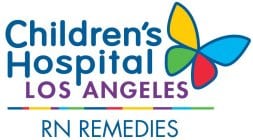 Did you know that peanut allergy is the third most common food allergy for children in America? To learn more, I partnered with Ronald Ferdman, MD, physician in theDivision of Clinical Immunology and Allergy at Children’s Hospital Los Angeles. I’ll explain how you can help manage your child’s peanut-free lifestyle during grocery shopping and at school.
Did you know that peanut allergy is the third most common food allergy for children in America? To learn more, I partnered with Ronald Ferdman, MD, physician in theDivision of Clinical Immunology and Allergy at Children’s Hospital Los Angeles. I’ll explain how you can help manage your child’s peanut-free lifestyle during grocery shopping and at school.
Peanut Allergy Facts
A peanut allergy is a rapid reaction to the ingestion of peanuts. Symptoms can include:
 Skin reactions (atopic dermatitis – also known as eczema, or hives)
Skin reactions (atopic dermatitis – also known as eczema, or hives)- Cramps, nausea and diarrhea
- Aanaphylaxis – a potentially fatal constriction of the airways and swelling of the throat
Though these symptoms are similar to those of other food allergies, peanut allergy symptoms tend to be severe and account for the majority of fatal or near-fatal anaphylactic reactions in the United States.
A peanut-allergic person produces massive amounts of histamine as soon as peanuts are introduced into the body. Many peanut allergy sufferers also have tree nut allergies. For many, a peanut allergy is a lifelong problem. However, approximately 20 percent of infants with peanut allergy might outgrow the allergy.
Food Items That Might Contain Peanuts
| Baked goods | Granola |
| Candy (chocolate, nougat, candy with nut butter) | Ground or mixed nuts |
| Cereal | Ice cream and frozen desserts |
| Energy bars | Marzipan |
| Grain breads | Salad dressing |
How Do I Know If My Child Has A Peanut Allergy?
Usually, it is obvious that your child has a peanut allergy. Most children will react within minutes of eating any product containing peanuts. Common reactions include spitting out the food; an itchy mouth, tongue or throat; breaking out in hives, swelling or other itchy skin rashes; stomach aches or throwing up; and, if the allergy is severe, breathing problems. Children with milder allergies or who eat very small amounts of peanuts might have less-obvious symptoms. If you suspect your child is allergic to peanuts, your healthcare provider can arrange for an allergy test that will tell you without doubt.
If your child is diagnosed with a peanut allergy, your health care provider might prescribe an epinephrine auto-injector device, which contains a solution to be injected under your child’s skin if they experience a severe allergic reaction. I found a resource from the National Institutes of Health helpful for more information about epinephrine. If you have any questions, reach out to your child’s health care provider.
A Peanut-Free Lifestyle
Even though peanuts are found in a lot of foods, managing a peanut-free lifestyle can be less stressful with the following tips for grocery shopping, school, restaurants and travel.
GROCERY SHOPPING
- Read the labels on all manufactured foods.
- If the label says, “Produced in a factory that processes peanuts,” or one of the many other food advisory warnings, don’t buy it.
- Do not buy products with unclear labeling, such as pastries from a bakery case.
- If you’ve bought a manufactured food item in the past, continue checking the label each time you buy it. Ingredients can change.
- Create a peanut-fee home. Even if your other children do not have a peanut allergy, do not buy peanuts or peanut products. This helps eliminate cross-contamination.
SCHOOL
Peanut butter and jelly is a popular snack in many schools. Peanut butter is sticky and can lead to cross-contamination with other foods, and leave residue on lunch tables, hands or drinking fountains.
Call your child’s school before their first day and ask about the protocol for children with peanut allergy. Many schools have separate lunch tables for food allergic-children, or prohibit the presence of peanuts entirely.
- If your child is older, make an arrangement with the school and day camps for your child to carry their epinephrine auto-injector (emergency medicine) in their backpack at all times. If your child has an allergic reaction, the school will know how to find it.
- Make sure at least one school staff member knows how to operate an epinephrine auto-injector.
- Remind your child and school staff never to trade food with school mates, to be aware of foods during class birthday and holiday parties, and to tell an adult the moment they feel or witness symptoms.
- Encourage your child to wear a peanut allergy bracelet. There are cool-looking bracelets available online. Search “Food allergy bracelets for kids” on the Internet.
Click here for tips on managing peanut allergy at restaurants and during travel.
Knowledge is power, and being aware of food labels and ingredients in recipes, talking to your child’s school and making special arrangements during travel will help protect your child from having an allergic reaction. Also, don’t forget to carry your child’s epinephrine auto-injector at all times.
For more of Robert’s pediatric health care tips, visit WeTreatKidsBetter.org.

























